Ensuring personal safety on the roads presentation. Road traffic, road safety
1 slide
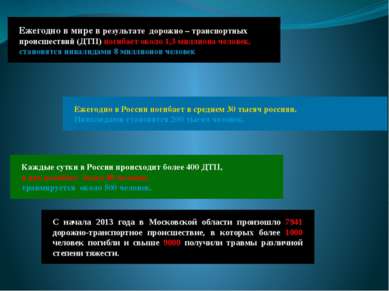
2 slide
Every year in the world as a result of road - traffic accidents(RTI) about 1.3 million people die, 8 million people become disabled Every day in Russia there are more than 400 road accidents, more than 80 people die in them, about 500 people are injured. An average of 30,000 Russians die in Russia every year. 200 thousand people become disabled. Since the beginning of 2013, 7,941 traffic accidents have occurred in the Moscow Region, in which more than 1,000 people died and more than 9,000 were injured of varying severity.
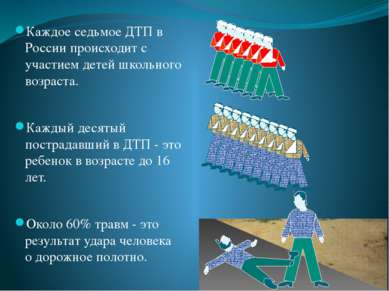
3 slide
Every seventh road accident in Russia occurs with the participation of school-age children. Every tenth victim in an accident is a child under the age of 16. About 60% of injuries are the result of a person hitting the roadway.
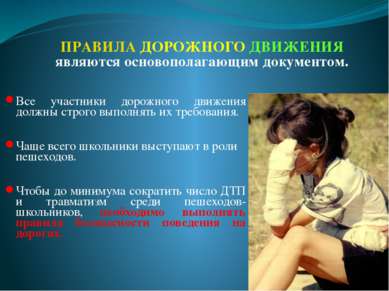
4 slide
REGULATIONS OF THE TRAFFIC are the fundamental document. All participants traffic must strictly comply with their requirements. Most often, students act as pedestrians. To minimize the number of accidents and injuries among school pedestrians, it is necessary to follow the rules of safe behavior on the roads.
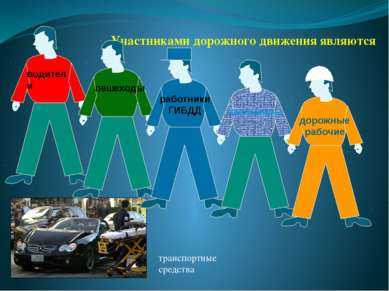
5 slide
Road users are vehicles, drivers, pedestrians, traffic police officers, road workers.
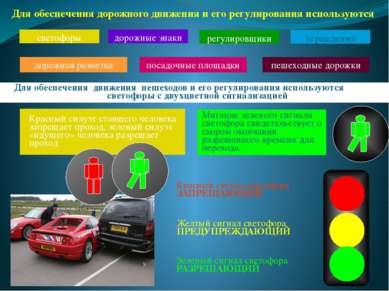
6 slide
Red traffic light signal FORBIDDEN Yellow traffic light signal WARNING Green traffic light signal PERMISSIBLE walking paths landing pads road markings guardrails traffic signs road signs traffic lights To ensure the movement of pedestrians and its regulation, traffic lights with two-color signaling are used. The red silhouette of a standing person prohibits passage, the green silhouette of a “walking” person allows passage.
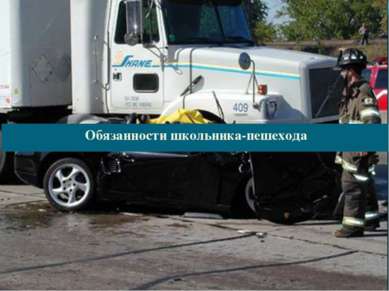
7 slide
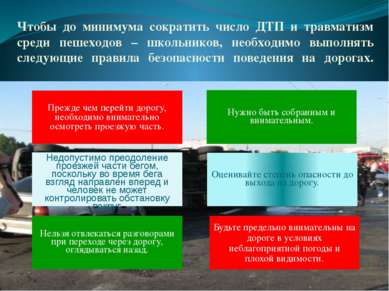
8 slide
In order to minimize the number of accidents and injuries among pedestrians - schoolchildren, it is necessary to carry out following rules road safety. Before crossing the road, you must carefully inspect carriageway. It is unacceptable to overcome the roadway by running, because during the run the gaze is directed forward and the person cannot control the situation around. You can not be distracted by conversations when crossing the road, look back. You need to be collected and attentive. Assess the degree of danger before entering the road. Be extremely careful on the road in adverse weather and poor visibility.
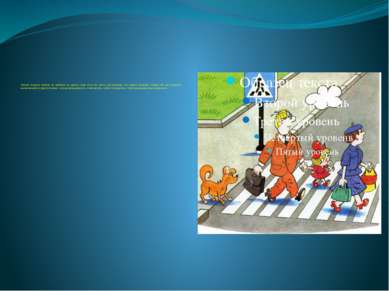
9 slide
A smart pedestrian will never run out onto the road, even if it is a crossing point. He will go quietly, because for a driver a person who jumps out onto the road is always a surprise, and it is not known whether the driver will be able to cope with this surprise.
![]()
10 slide
It is dangerous to play next to the road: ride a bike in summer or sled in winter. Currently, we are seeing that more and more guys, walking down the street, listen to music, wearing headphones. This is very distracting - the child does not hear what is happening around him, and he may not hear the approaching vehicle or driver's signal. Another trouble, both for drivers and for pedestrians, is a conversation on mobile phone. While talking on the phone, a person is distracted, the driver may not notice the pedestrian, and the pedestrian may not notice the driver.
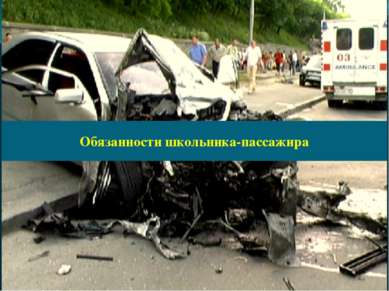
11 slide
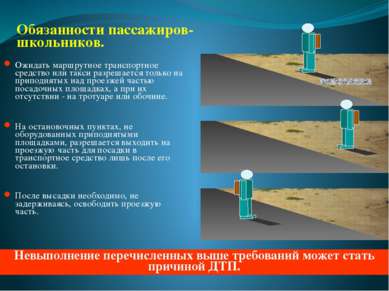
12 slide
Responsibilities of student passengers. It is allowed to wait for a shuttle vehicle or a taxi only on elevated carriageway landing sites, and in their absence - on the sidewalk or roadside. At stopping points that are not equipped with raised platforms, it is allowed to enter the carriageway to board the vehicle only after it has stopped. After disembarking, it is necessary, without delay, to clear the roadway. Failure to comply with the above requirements may result in an accident.
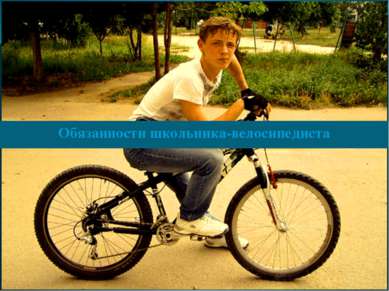
13 slide
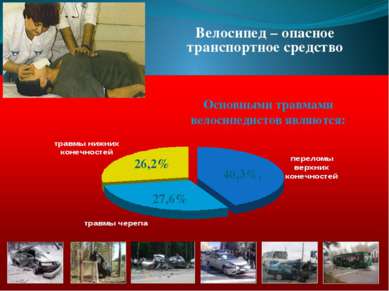
14 slide
40.3%, 27.6% 26.2% The main injuries of cyclists are: Bicycle is a dangerous vehicle
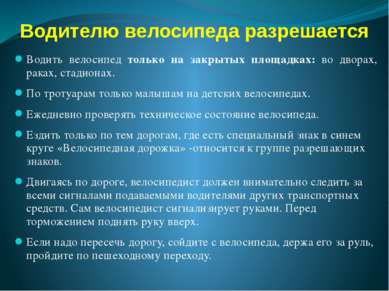
15 slide
A bicycle driver is allowed to ride a bicycle only in closed areas: in yards, shrines, stadiums. On the sidewalks only for kids on children's bicycles. Check daily technical condition bike. Drive only on roads where there is a special sign in blue circle"Bicycle path" - refers to the group of permit signs. When moving along the road, the cyclist must carefully follow all the signals given by the drivers of other Vehicle. The cyclist himself signals with his hands. Before braking, raise your hand up. If you need to cross the road, get off the bike, holding the handlebars, go through the pedestrian crossing.
Subject: No. 2 dangerous situations man-made nature.
Lesson #1
Road traffic, road safety.
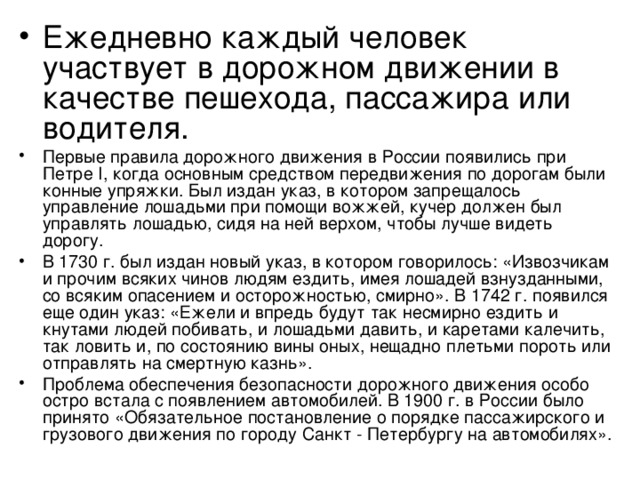
- Every day every person participates in traffic as a pedestrian, passenger or driver.
- The first rules of the road in Russia appeared under Peter I, when horse teams were the main means of transportation on the roads. A decree was issued in which it was forbidden to drive horses with the reins, the driver had to drive the horse while riding it in order to better see the road.
- In 1730, a new decree was issued, which stated: “For cab drivers and other people of all ranks, ride with horses bridled, with all fear and caution, quietly.” In 1742, another decree appeared: “If they continue to drive so unruly and beat people with whips, and crush with horses, and cripple with carriages, so catch and, as a result of their guilt, mercilessly flog with whips or send them to death.”
- The problem of ensuring road safety has become especially acute with the advent of cars. In 1900, Russia adopted the "Compulsory Decree on the procedure for passenger and freight traffic in the city of St. Petersburg by car."
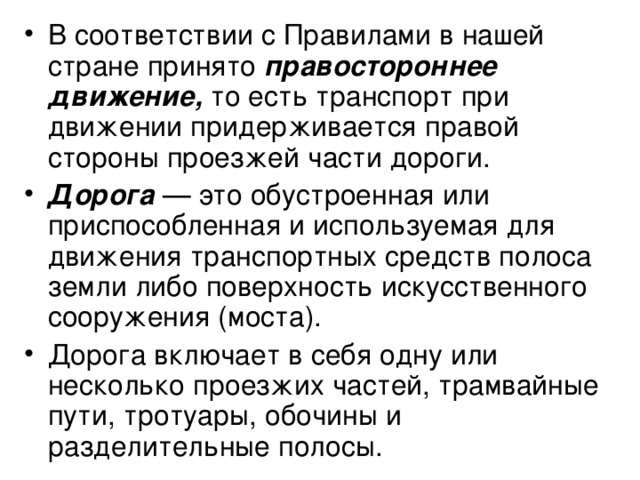
- In accordance with the Rules in our country, it is accepted right hand traffic, that is, when moving, the transport adheres right side carriageway.
- Road - it is a strip of land or a surface of an artificial structure (bridge) equipped or adapted and used for the movement of vehicles.
- The road includes one or more carriageways, tram tracks, sidewalks, shoulders and dividing lanes.
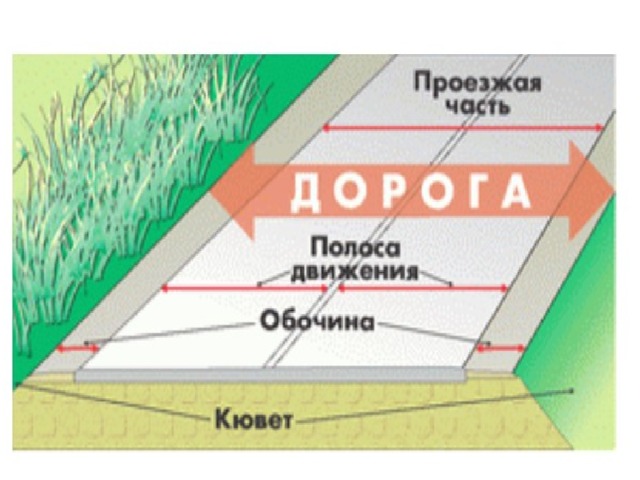
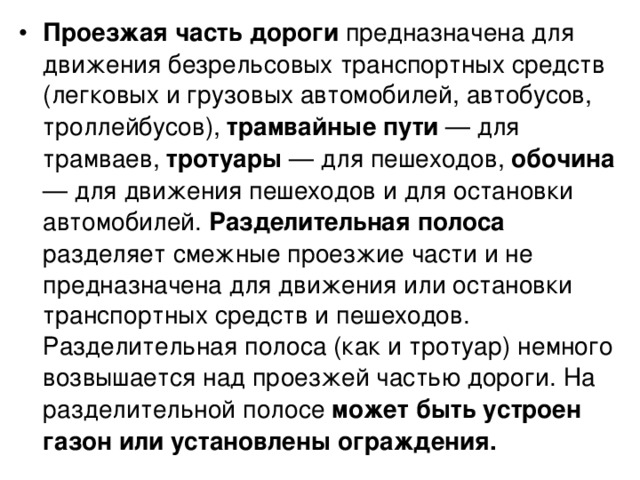
- The carriageway of the road designed for the movement of trackless vehicles (cars and trucks, buses, trolleybuses), tram rails- for trams, sidewalks- for pedestrians, roadside- for the movement of pedestrians and for stopping cars. dividing line separates adjacent carriageways and is not intended for the movement or stopping of vehicles and pedestrians. The dividing strip (like the sidewalk) rises slightly above the carriageway. On the dividing line a lawn can be arranged or fences installed.
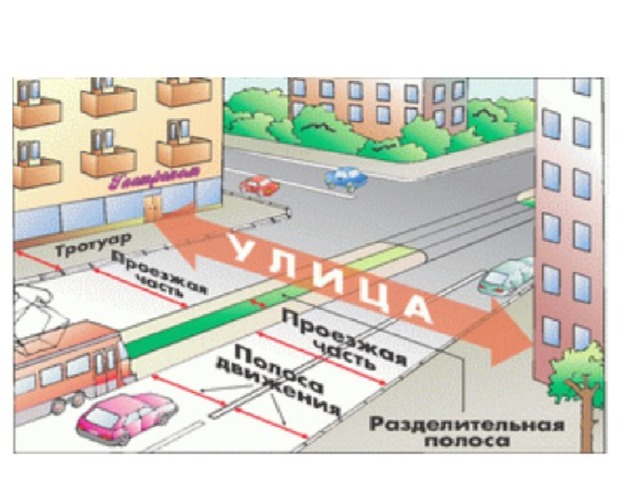
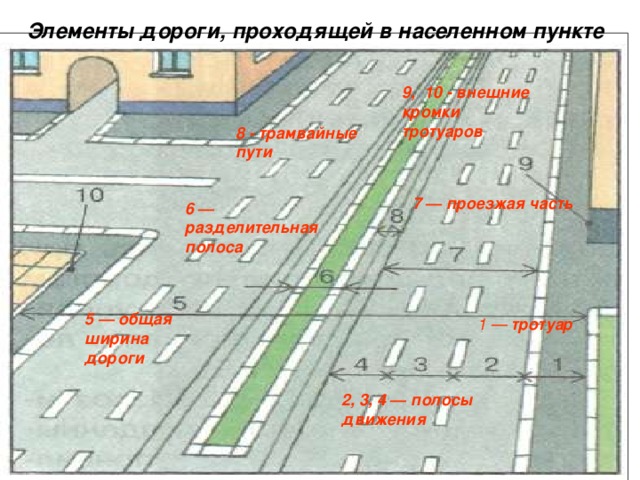
Elements of the road passing through the village
9, 10 - outer edges
sidewalks
8 - tram
way
7 - roadway
6 - dividing line
5 - total width of the road
1 - sidewalk
2, 3, 4 - stripes
movements
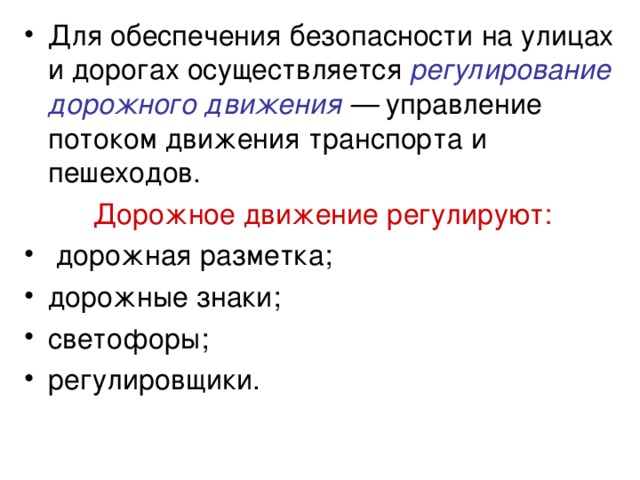
- To ensure safety on the streets and roads, traffic control - control of the flow of traffic and pedestrians.
Traffic is regulated by:
- road markings;
- road signs;
- traffic lights;
- traffic controllers.
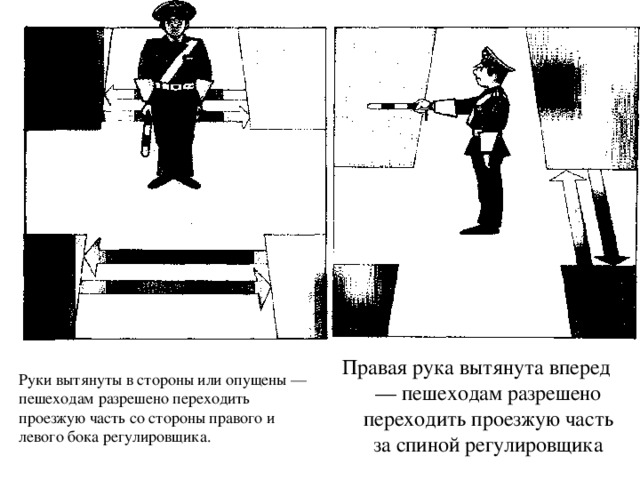
Right arm extended forward - pedestrians are allowed to cross the roadway behind the back of the traffic controller
Hands extended to the sides or lowered - pedestrians are allowed to cross the carriageway from the right and left sides of the traffic controller.
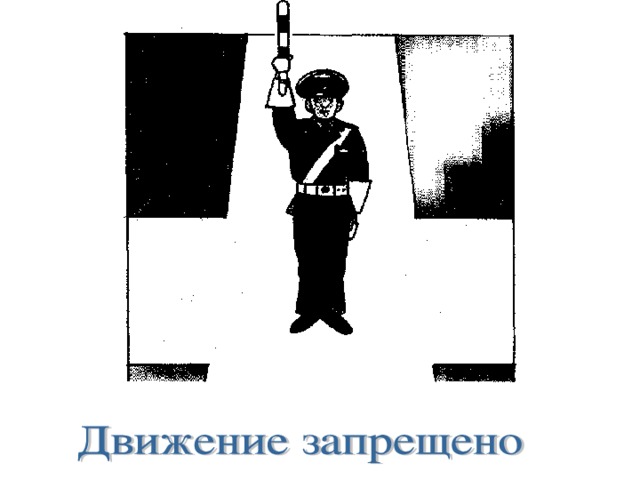
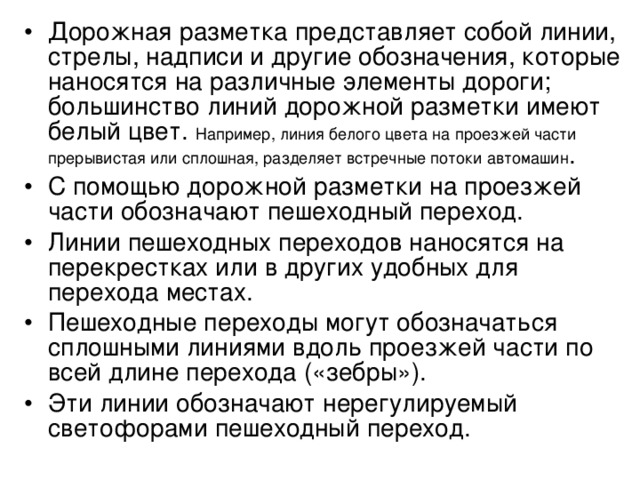
- Road markings are lines, arrows, inscriptions and other designations that are applied to various elements of the road; most road marking lines are white. For example, line white color on the roadway intermittent or continuous, separates oncoming traffic flows.
- Pedestrian crossings are marked with road markings on the carriageway.
- Pedestrian crossing lines are drawn at intersections or other places convenient for crossing.
- Pedestrian crossings may be marked solid lines along the roadway along the entire length of the crossing (“zebras”).
- These lines indicate a pedestrian crossing that is not regulated by traffic lights.
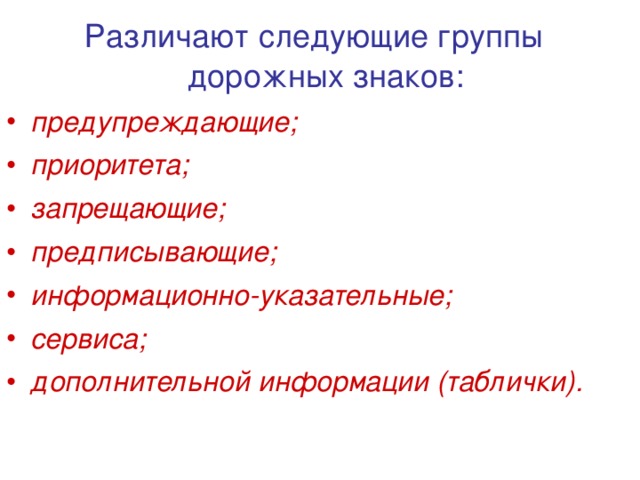
- warning;
- priority;
- forbidding;
- prescriptive;
- information and indication;
- service;
- additional information (plates).
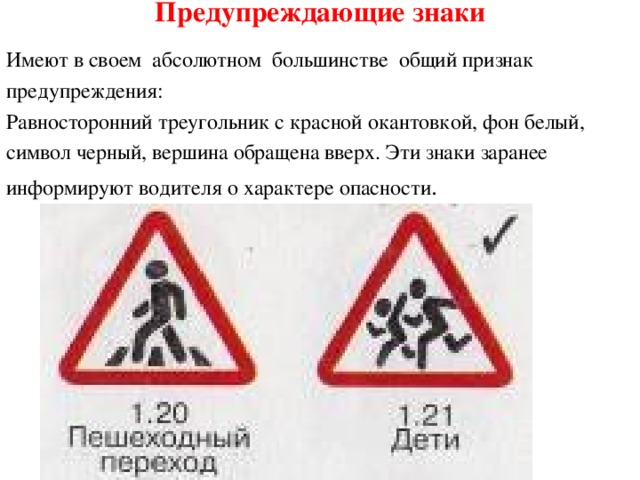
warning signs
Most of them have a common feature
warnings:
Equilateral triangle with red border, white background,
the symbol is black, the top is facing up. These signs in advance
inform the driver about the nature of the danger.
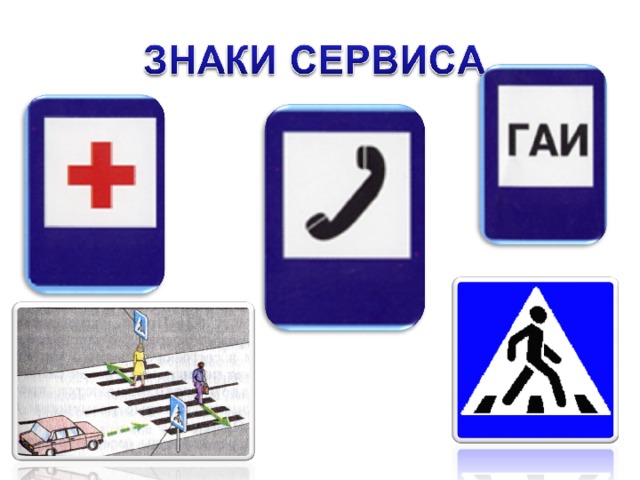
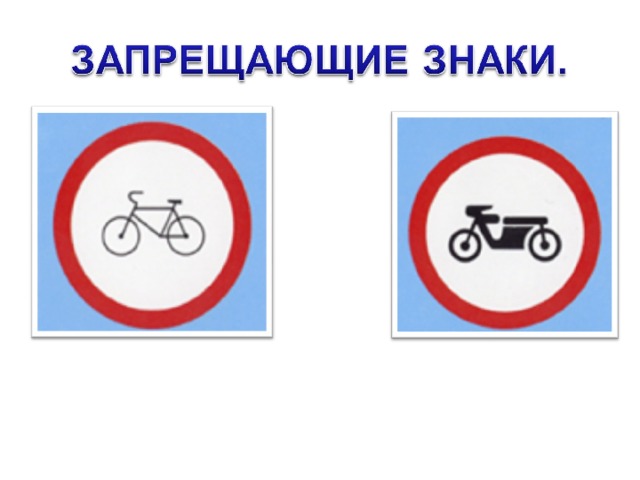
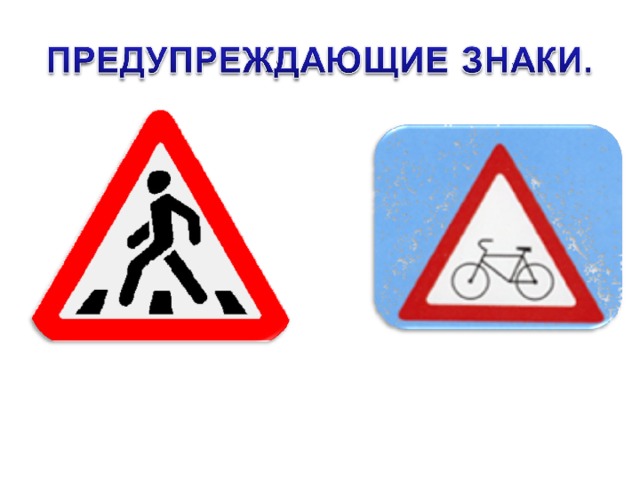
Presentation on the topic: Road safety
1 of 16
Presentation on the topic: Road Safety
slide number 1
Description of the slide:
slide number 2
Description of the slide:
slide number 3
Description of the slide:
Rules of conduct at landing sites and in route transport: While waiting for transport, you must not go out onto the carriageway; Disembarkation and landing in the route transport should be carried out from the sidewalk or roadside and only after a complete stop; Do not get close to the edge of the carriageway, especially in winter. You can not distract the driver with conversations and knock on the cab glass; One must be polite and give way to elderly passengers, small children and the disabled; You can't lean out of the windows.
slide number 4
Description of the slide:
Pedestrian crossings A pedestrian crossing serves to cross the road. For availability pedestrian crossing indicates a road sign in the form of a blue square with a walking man. Road markings "zebra" indicate the location of the pedestrian crossing on the carriageway. If a traffic light is installed at a pedestrian crossing, then the pedestrian crossing is called regulated. If there is no traffic light at the pedestrian crossing, then it is called unregulated. Road sign and road markings indicate the location of the pedestrian crossing on the road. The transition must be done according to the rules!
slide number 5
Description of the slide:
traffic light traffic light technical device, which serves to regulate the movement of vehicles and pedestrians. Traffic lights are for vehicles and pedestrians. The traffic light regulates the movement of vehicles, it has three signals - red, yellow and green. A pedestrian traffic light regulates the movement of pedestrians. It has two signals - red and green. Traffic and pedestrian traffic lights installed at crossroads and pedestrian crossings operate in concert with each other. If a red or yellow signal is lit at a traffic light, then a green signal is lit at a pedestrian traffic light at that time.
slide number 6
Description of the slide:
You are a pedestrian Leaving the entrance of your house, you become a pedestrian and have a purpose of movement and a place where you are going. In addition to the goal, everyone chooses their own route for walking. The route is the path of our movement to the goal. Pedestrians become road users when they walk along the road and its surrounding areas. Pedestrian traffic begins in the courtyard of the house. Pedestrians walk along the sidewalks, cross the carriageway in the yard. After leaving the courtyard, pedestrians continue to walk along the sidewalks. To cross to the other side of the street, they use pedestrian crossings.
slide number 7
Description of the slide:
Rule #1 Choose safe place for the transition. If there is no pedestrian or traffic light crossing nearby, choose a location where you can clearly see the road in all directions. Don't try to get on the road between standing cars. It is important that not only you have a good view of the road, but also that you are clearly visible to any driver. Having chosen a place suitable for the transition, wait, look around ...
slide number 8
Description of the slide:
slide number 9
Description of the slide:
slide number 10
Description of the slide:
Rule #4 If a car is approaching, let it pass, then look around again and listen for other cars nearby. When the car passes, you need to look around again. In the first seconds, she can obscure a car that is driving towards her. Without noticing it, you can fall into the "trap" ...
slide number 11
Description of the slide:
Description of the slide:
Rule number 7 If during the transition suddenly there was an obstacle to the view (for example, the car stopped due to a malfunction), carefully looking out from behind it, inspect the rest of the way. Step back if necessary. You need to behave in such a way that you can be clearly seen by passing drivers ...
slide number 14
Description of the slide:
Rules of the road for cyclists Riding a bicycle while driving on roads is allowed for persons not younger than 14 years old, and a moped - not younger than 16 years old. Bicycles, mopeds must move only in the rightmost lane in one row. Driving on the side of the road is allowed if it does not interfere with pedestrians. Columns of cyclists must be divided into groups of 10 cyclists. To facilitate overtaking, the distance between groups should be 80 - 100 meters.
slide number 15
Description of the slide:
Bicycle and moped riders are prohibited from: riding holding the steering wheel with one hand; carry passengers, except for a child under the age of 7, on an additional seat equipped with reliable footrests; transport cargo that protrudes more than 0.5 m in length or width, or cargo that interferes with control; move along the road if there is a nearby bike path; turn left or turn around on roads with tram traffic and on roads with more than one lane for traffic in a given direction.
slide number 16
Description of the slide:
References used http://yandex.ru/images/search?text http://www.tvoyrebenok.ru/rules_of_traffic_to_children.shtml http://pochemu4ka.ru/load/doshkolnoe_obrazovanie/pravila_dorozhnogo_dvizhenija/182 http://mir.pravo .by/library/azbuka/azbukadorbez/traffic-rules/ https://www.gibdd.ru/news/federal/211496/





